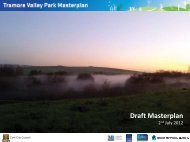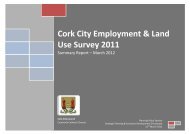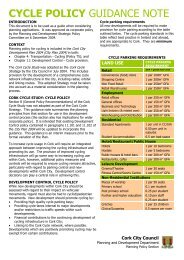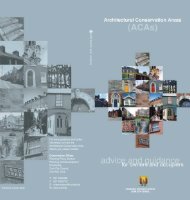City of Differences Summary - Cork City Council
City of Differences Summary - Cork City Council
City of Differences Summary - Cork City Council
You also want an ePaper? Increase the reach of your titles
YUMPU automatically turns print PDFs into web optimized ePapers that Google loves.
<strong>City</strong> <strong>of</strong> DifferenceMapping Social Exclusion in <strong>Cork</strong>Cathair na hIlíochtaMapáil an Eisiata Sóisialta i gCorcaighSUMMARYClaire EdwardsDenis Linehan
Key Indicators:POPULATION:There has been a 3.2% decline in <strong>Cork</strong> <strong>City</strong>’s population 1996-2002.Since 1986, there has been an 11.6% increase in the number <strong>of</strong> those aged 65+in the <strong>City</strong>’s population, and a significant decrease (37.3%) in the proportion<strong>of</strong> 0-14 year olds, reflecting in part a drop in fertility rate and the location <strong>of</strong> youngfamilies to outside the <strong>City</strong> boundary.In 2002, the largest proportion <strong>of</strong> the <strong>City</strong>’s population fell into the 25-44 age bracket.However, the age composition <strong>of</strong> the population differs spatially across the <strong>City</strong>. Many <strong>of</strong> the<strong>City</strong> Centre DEDs have much higher proportions <strong>of</strong> their population falling into the15-44 age category compared to outer areas, whilst having relatively small proportions<strong>of</strong> those aged 0-14.In contrast, some <strong>of</strong> the outer wards have younger population pr<strong>of</strong>iles. For example,just under a third <strong>of</strong> the populations <strong>of</strong> Knocknaheeny (29.5%), Mayfield (30%) and tothe south east, Mahon B (30%) are aged under 15, proportions considerably higherthan the figure <strong>of</strong> 17.2% for the <strong>City</strong> overall. These areas also have particularly highyoung dependency ratios (derived by calculating the population aged 0-14 as apercentage <strong>of</strong> the working age population (15-64)), which in some cases are almostdouble those <strong>of</strong> the <strong>City</strong>’s overall young dependency ratio <strong>of</strong> 24.5% (Knocknaheeny:45.2%; Mayfield: 47.1%; Mahon B: 45.9%).There are particularly high proportions <strong>of</strong> people aged 15-24 in the DEDs just tothe south west <strong>of</strong> the <strong>City</strong> centre, reflecting the high number <strong>of</strong> students living inthe area, in close proximity to UCC and CIT.In terms <strong>of</strong> the over 65 population, it is the south central DEDs which have some <strong>of</strong>the highest proportions <strong>of</strong> this age group, perhaps reflecting the more establishedresidential status <strong>of</strong> these areas. Over a quarter <strong>of</strong> the populations <strong>of</strong> Turner’s Cross Aand D and Tramore A are aged over 65, whilst Togher B, Pouladuff A and B, Turner’sCross B, Ballyphehane B and Knockrea A have similarly high proportions relative to therest <strong>of</strong> the <strong>City</strong>.The city centre contains the greatest proportions <strong>of</strong> people <strong>of</strong> non-Irish / UKnationality in the <strong>City</strong>; just under a third <strong>of</strong> the populations <strong>of</strong> Shandon B and CentreA are <strong>of</strong> people <strong>of</strong> non-Irish / UK nationality. Commons, to the north, and St. Patrick’sand Tivoli A also have high proportions. These areas typically have high proportions <strong>of</strong>privately rented accommodation.
CITY OF DIFFERENCE MAPPING SOCIAL INCLUSION IN CORKwww.corkcity.ie/socialinclusionThere are 860 members <strong>of</strong> the Traveller Community in <strong>Cork</strong> <strong>City</strong>. Blackpool A has thehighest proportion <strong>of</strong> members <strong>of</strong> the Traveller Community within its total population,<strong>of</strong> 7.96%. The adjacent DEDs <strong>of</strong> The Glen and Mayfield also have higher proportionsrelative to the rest <strong>of</strong> the <strong>City</strong>, as do Shanakiel and Bishopstown A to the west andMahon B in the south east.There are 13,791 people with a long lasting health problem or disability in <strong>Cork</strong><strong>City</strong>, representing 11.2% <strong>of</strong> the total population. The patterning <strong>of</strong> disability across the<strong>City</strong> varies by age group.1• 23.9% (3,295) people experienced blindness or deafness, or a severe vision orhearing impairment.• 30.2% (4,171) stated they had difficulty in learning, concentrating or remembering.• 55.1% (7,603) said their condition limited them substantially in basic physicalactivities.2• 57.4% (7,911) said they experienced difficulty in working at a job or business.• 35.7% (4,926) said they had difficulty getting outside the home alone.• 24.9% (3,436) said they had difficulty in dressing, bathing or getting around insidethe home.Unsurprisingly, rates <strong>of</strong> disability increase with age. For example, 15-24 year oldsaccount for only 6.0% <strong>of</strong> all disabled people in the <strong>City</strong>; in contrast, 39.1% <strong>of</strong> thedisabled population is aged 65 and over.In terms <strong>of</strong> the overall disabled population, the largest concentration is to be found inTramore A. However, it is likely that this is something <strong>of</strong> an anomaly created by thepresence <strong>of</strong> St. Finbarr’s Hospital in this DED. Overall, the statistics don’t show aparticularly strong pattern, although it can be seen that a number <strong>of</strong> north western/central wards have above average rates <strong>of</strong> disability amongst their populations,including Shandon A, Gurranebraher, Churchfield, Fairhill B and Farranferris B (all <strong>of</strong>which have rates ranging from 14.9 – 19.5%). In the south, Pouladuff, Turner’s CrossC and <strong>City</strong> Hall A also have similar proportions.There are 4,954 carers in <strong>Cork</strong> <strong>City</strong>, representing 4.9% <strong>of</strong> the total population agedover 15. More females than males in the <strong>City</strong> are providing care; 5.7% <strong>of</strong> allwomen aged 15+ (3,046) are providing help, compared to 3.9% (1,908) <strong>of</strong> men.HOUSEHOLDS:There are 5,202 lone parent households in <strong>Cork</strong> <strong>City</strong> representing 12.2% <strong>of</strong> all privatehouseholds in the <strong>City</strong>. Some <strong>of</strong> the highest proportions <strong>of</strong> lone parent households are1. These percentages do not total 100% because a person could fall into more than one <strong>of</strong> these categories.2. However, we do not know the employment status <strong>of</strong> these people.
CITY OF DIFFERENCE MAPPING SOCIAL INCLUSION IN CORKwww.corkcity.ie/socialinclusionfound in the Northside DEDs. ; for example, 29.5% <strong>of</strong> all households in Knocknaheenyare lone parent households, as are 28.3% <strong>of</strong> households in Mayfield. To the south <strong>of</strong>the <strong>City</strong>, 21.8% <strong>of</strong> Mahon B’s households consist <strong>of</strong> lone parent families.Older people make up a significant proportion <strong>of</strong> one-person households in <strong>Cork</strong> <strong>City</strong>.In 2002, there were 10, 977 one person households in the <strong>City</strong>. Of these,4,253 (or 38.7%) were <strong>of</strong> people aged 65+. The increase in the numbers <strong>of</strong> thoseaged 65+ living alone is set to continue as the total 65+ population increases.There are 14,053 people aged 65 years and over living in private households in <strong>Cork</strong><strong>City</strong>. Of these, 30.3% (4,253) are living alone in private households. Unsurprisingly, thisproportion is much higher for women (37.8%) than it is for men (19.8%).The DEDs with the greatest proportions <strong>of</strong> those living alone who are aged 65+ arescattered across the southern side <strong>of</strong> the <strong>City</strong>, including areas such as Pouladuff,Glasheen C, Turner’s Cross D, and Bishopstown C. Between 55 and 77% <strong>of</strong> all peopleliving alone in these areas fall into the over 65 age group. This patterning is perhapsnot surprising, given that these areas have some <strong>of</strong> the greatest proportions <strong>of</strong> theirpopulation falling into the 65+ age category.31.2% <strong>of</strong> permanent private households in the <strong>City</strong> are owner occupiedwithout a loan or mortgage.According to the 2002 Census there are 5,950 permanent private households beingrented from the Local Authority in <strong>Cork</strong> <strong>City</strong>, constituting 14.0% <strong>of</strong> all households inthe <strong>City</strong> (see Table 22, Appendix A). It Should be highlighted that according to <strong>Cork</strong> <strong>City</strong><strong>Council</strong>’s administrative records, in September 2003, 7,249 dwelling units were rented by <strong>Cork</strong><strong>City</strong> <strong>Council</strong>.18.3% (7,830) <strong>of</strong> households in the <strong>City</strong> are privately rented: the majority <strong>of</strong> these arerented part or fully furnished.Some 8,238 households in <strong>Cork</strong> <strong>City</strong> report having no central heating. There is aclear concentration <strong>of</strong> households without central heating in the most central DEDs<strong>of</strong> the <strong>City</strong>, where between 30.8-42% <strong>of</strong> all permanent private households have nocentral heating. These areas have particularly high proportions <strong>of</strong> privately rentedaccommodation. Moving out to Blackpool A and Tivoli A to the north and eastrespectively, and to Mardyke to the south west: 30.86 - 42% <strong>of</strong> all households in theseareas, along with Knocknaheeny to the north west, have no central heating. Theseareas have particularly high proportions <strong>of</strong> privately rented accommodation, and in thecase <strong>of</strong> Knocknaheeny, local authority housing. In contrast, the Bishopstown wards tothe south west, and further to the south east, Knockrea A, Ballinlough and Tramorehave lower than average proportions <strong>of</strong> households without central heating (3.60 – 10.41%).Just over a third (36.1%) <strong>of</strong> households in <strong>Cork</strong> <strong>City</strong> have a PersonalComputer (PC). It is the more affluent DEDs to the south <strong>of</strong> the <strong>City</strong> which have thehighest proportions <strong>of</strong> households with a PC: with the exception <strong>of</strong> Sunday’s Well A, allDEDs reporting proportions <strong>of</strong> over 50% <strong>of</strong> households with a PC are to be found onthe south side.Over a third (34.2%) <strong>of</strong> <strong>Cork</strong> <strong>City</strong>’s households have no car. 25.8% <strong>of</strong>households have 2 or more cars. Again, the greatest proportions <strong>of</strong> householdsowning 2 or more cars are to be found in the DEDs to the south <strong>of</strong> the <strong>City</strong>.
EDUCATION:Trends in educational qualifications in the <strong>City</strong> show a positive change since 1996: therehas been a 6.2% decline in the proportion <strong>of</strong> those people whose highest level <strong>of</strong>education is primary education (a change from 27.7% in 1996 to 21.5% in 2002), and a5% increase in those completing third level education (19.5% in 1996 to 24.4%).There is a distinct patterning <strong>of</strong> educational attainment across the <strong>City</strong>. 35% <strong>of</strong> the<strong>City</strong>’s population whose education has ceased, left school at 16 or under. However, theseproportions are considerably higher for a number <strong>of</strong> northern wards in the <strong>City</strong>,including Knocknaheeny, Fairhill B and C, Churchfield, Farranferris B and C, GurranebraherE, Blackpool A, The Glen A, where over 50% <strong>of</strong> the 15+ population ceased theireducation at age 16 or under. A cluster <strong>of</strong> wards on the south <strong>of</strong> the <strong>City</strong> – inparticular, Ballyphehane A, Pouladuff A and B, Togher B - also had proportions above 50%.The south <strong>of</strong> the <strong>City</strong> contains more DEDs with greater proportions <strong>of</strong> people with auniversity degree as their highest qualification, with proportions ranging up to 10% <strong>of</strong>the over 15 population. In contrast, many northern DEDs – in particular Knocknaheeny,Fairhill, The Glen A and Mayfield – have around 1% or less <strong>of</strong> their populationscompleting a degree; between a quarter and a third <strong>of</strong> people in these areas finish theireducation at Lower Secondary Level.SOCIO-ECONOMICGROUPS (SEG):There has been a decline between 1996 and 2002 in the proportion <strong>of</strong> thosedefined as ‘Unskilled’ (from 9.3% to 6.4%) and ‘Manual skilled’ (15.9% to 10.9%),and an increase in SEG A, ‘Employers and managers’ (from 9.1 to 11.7%). In part,this reflects the changing nature <strong>of</strong> <strong>Cork</strong>’s industrial pr<strong>of</strong>ile, which has shifted awayfrom traditional industries such as textiles, food and car assembly requiring manualskills, to more modern sectors including pharmaceuticals, electronics, and servicebased activities (including pr<strong>of</strong>essional services such as health and education) 33. <strong>Cork</strong> Corporation (1990) Northside Study; <strong>Cork</strong> <strong>City</strong> <strong>Council</strong> (2004) <strong>Cork</strong> <strong>City</strong> Development Plan 2004, Planning andDevelopment Directorate.
Despite these overall changes, there remain spatial inequalities in the patterning <strong>of</strong>SEGs across the <strong>City</strong>. The majority <strong>of</strong> DEDs in the north <strong>of</strong> the city have the lowestproportions <strong>of</strong> people who fall into the ‘Higher pr<strong>of</strong>essionals’ SEG, where no more thanaround 2% <strong>of</strong> people are ‘Higher pr<strong>of</strong>essionals’. In contrast, up to a fifth <strong>of</strong> thepopulations <strong>of</strong> certain DEDs within the south <strong>of</strong> the <strong>City</strong> – Knockrea B, Browningstown,Bishopstown A and Sunday’s Well A – are made <strong>of</strong> up <strong>of</strong> ‘Higher Pr<strong>of</strong>essionals’. Thispatterning is perhaps not surprising given that pr<strong>of</strong>essional services (particularly healthand education) are responsible for over half (56%) <strong>of</strong> employment in the south west4<strong>of</strong> the <strong>City</strong> , and that, as the previous section showed, these areas have higher thanaverage proportions <strong>of</strong> their populations achieving a third level qualification.As with educational qualifications, therefore, we can see a reversal <strong>of</strong> the patterningwhen it comes to those defined as ‘Unskilled’ (SEG G): the highest proportions <strong>of</strong> thisSEG can be found in the north west wards <strong>of</strong> Knocknaheeny, Churchfield, Fairhill B,Gurranabraher E and D: some 12.8 –18.6% <strong>of</strong> the populations here fall into thisSocio-Economic Group. These areas have high rates <strong>of</strong> early school leaving, highproportions <strong>of</strong> local authority housing, and as the previous section noted, havetraditionally been dependent on traditional manufacturing industries for employment.As the 1990 Northside Study suggested, the economic recession <strong>of</strong> the 1980s andsubsequent restructuring <strong>of</strong> <strong>Cork</strong>’s economy around industries requiring a different(and sometimes more specialised) skills base has contributed to a jobs-skills mismatchfor many people in these areas. These areas have also been less able to attract newenterprises/industries, despite the overall growth in employment in the <strong>City</strong> over thelast few years.LABOUR FORCE &UNEMPLOYMENT:In 2002, 52.2% (53,274) <strong>of</strong> <strong>Cork</strong> city’s population aged 15+ were in the labourforce. This is a slight increase on the 1996 participation rate <strong>of</strong> 51.2%. There is agender differential underpinning this trend; female participation in the labourmarket increased between 1996 and 2002 by some 4.1%, whilst in contrast, theproportion <strong>of</strong> men in the labour market decreased by 2.5%.The overall unemployment rate for <strong>Cork</strong> <strong>City</strong> is 12.4%. It is higher for males (14.2%)than for females (10.1%). The <strong>City</strong> has experienced a dramatic fall in unemployment ratesbetween 1986 and 2002, from 22.5% to 12.4%, reflecting national economic growth.Despite the fall in overall unemployment rates, <strong>Cork</strong> <strong>City</strong> has 11 <strong>of</strong> the State’s 88 worst5unemployment blackspots, which have average unemployment rates <strong>of</strong> 24.7%. These4. <strong>Cork</strong> <strong>City</strong> <strong>Council</strong> (2004) <strong>Cork</strong> <strong>City</strong> Development Plan 2004, Planning and Development Directorate; <strong>Cork</strong> <strong>City</strong>Development Board (2001) <strong>Cork</strong> <strong>City</strong>: Analysis <strong>of</strong> Present Economic, Social and Cultural Situation (draft).5. Blackspots are DEDs where the labour force exceeds 200 persons and its unemployment rate exceeds 20%, and arehighlighted in bold in Table 6.
CITY OF DIFFERENCE MAPPING SOCIAL INCLUSION IN CORKwww.corkcity.ie/socialinclusionblackspots are concentrated on the north side <strong>of</strong> the <strong>City</strong> and include Blackpool A(23.3%), Churchfield (23.1%), Farranferris B (20.1%) and C (20.3%), Gurranebraher A(20.6%), B (20.3%), and E (21.4%), Knocknaheeny (27.3%), Mayfield (23.6%), ShandonB (23.4%), The Glen A (31.4%) (see Table 17). The continuing high unemployment ratesin many Northside DEDs bear witness to the wider socio-economic problems anddeprivation that exist in these areas, including as previous sections have highlighted,lower educational attainment, greater proportions <strong>of</strong> semi-skilled and unskilled workers,6and fewer employment opportuties in this part <strong>of</strong> the <strong>City</strong>.Some areas have a particularly young labour force; in Knocknaheeny, forexample, the largest proportion <strong>of</strong> the labour force is aged 15-24. Similarly, over 50%<strong>of</strong> the labour forces <strong>of</strong> Knocknaheeny, The Glen A, Mayfield and Churchfield are agedbetween 15-34; for Shandon B, this age group accounts for 70% <strong>of</strong> its labour force.Other areas have a labour force with an older age pr<strong>of</strong>ile, in particular GurranebraherA and B, where around a third <strong>of</strong> their workforce (31.3% and 36.7% respectively) isaged 45-65+. This is in marked contrast to Shandon B, where only 14.8% <strong>of</strong> theworkforce fall into this age group.Some 6,564 people in <strong>Cork</strong> <strong>City</strong> state they are unable to work due to permanentsickness or disability, representing 13.5% <strong>of</strong> all those not in the labour force inthe <strong>City</strong> and 6.4% <strong>of</strong> the total population aged 15 and over. The proportion <strong>of</strong> thosenot in the labour force citing that they are unable to work due to disability hasincreased by 4.7% since 1996. The highest proportions <strong>of</strong> those unable to work due todisability are found in the north western DEDs.CONCLUSIONS:The report used the Census to map key social and economic indicators across <strong>Cork</strong> city.The analysis presented recognises that social exclusion is a multi-faceted process,resulting from a range <strong>of</strong> interrelated factors including low income, lack <strong>of</strong> opportunity,and a diminished quality <strong>of</strong> life. The evidence presented in the report shows that thereare substantial, and in some cases, long-standing, inequalities in the social andeconomic fabric <strong>of</strong> the city.Some key messages about the socio-economic pr<strong>of</strong>ile <strong>of</strong> <strong>Cork</strong> emerge from thedata and maps:1. There have been some key changes in the overall socio-economiccharacteristics <strong>of</strong> <strong>Cork</strong> in the period 1996 to 2002. The most notable economic trend6. <strong>Cork</strong> <strong>City</strong> <strong>Council</strong> (2004) <strong>Cork</strong> <strong>City</strong> Development Plan 2004, Planning and Development Directorate.
CITY OF DIFFERENCE MAPPING SOCIAL INCLUSION IN CORKwww.corkcity.ie/socialinclusionhere is the decline in unemployment, which has fallen by around 8% between1996-2002. The dynamics <strong>of</strong> labour market participation have also changed, with anincreasing proportion <strong>of</strong> women now in employment. Simultaneously, there has alsobeen an increase in the proportion <strong>of</strong> people who are unable to work due to illness/disability. In terms <strong>of</strong> socio-economic status, there has been a small increase in theproportions <strong>of</strong> the population who fall into the higher Socio-Economic Groups(Employers and managers, higher pr<strong>of</strong>essionals, for example), and a decline in theproportion <strong>of</strong> manual skilled and unskilled Socio-Economic Groups, reflecting changesin the structure <strong>of</strong> the city’s industrial economy. In educational terms, there has beena 6.2% decrease in the proportion <strong>of</strong> the population who finish school at primaryeducation level (or have no formal education at all), and an increase in thosecompleing a degree or higher level <strong>of</strong> education.2. Despite these changes in the city, there are still considerable spatial inequalitiesin <strong>Cork</strong>, many <strong>of</strong> which focus around the north/south distinction and have beenwell-documented. For example, it is the wards on the north <strong>of</strong> the city: for example,Knocknaheeny, Gurranebraher, Mayfield, The Glen A - which have the highest rates <strong>of</strong>unemployment, the greatest proportion <strong>of</strong> their populations leaving school at LowerSecondary level, and above average proportions <strong>of</strong> unskilled workers. The north-west<strong>of</strong> the city also has higher proportions <strong>of</strong> people who cannot work due to disability: overtwenty five percent <strong>of</strong> those who are not in the labour force in this area (as opposedto thirteen percent for the city as a whole) are unable to work due to a permanentillness or disability. There are some areas on the southside <strong>of</strong> the city, such as MahonB and Togher, which should be noted as having higher than average rates <strong>of</strong> thesecriteria, but it is the wards <strong>of</strong> the northside which more stand out as moreconsistently disadvantaged across a range <strong>of</strong> indicators.3. In the period 1996-2002, when there was a 12.3% increase in the nationalpopulation, <strong>Cork</strong> <strong>City</strong>'s population decreased at a rate <strong>of</strong> 3.2 %. The context <strong>of</strong> theselow levels <strong>of</strong> population growth plays a key role in shaping the socio-economic pr<strong>of</strong>ile<strong>of</strong> the city. Firstly, emigration during the 1980s and 1990s removed a significantproportion <strong>of</strong> the population from the city who would now be expected to startingfamilies. Secondly, younger peopleand families on medium incomes have increasinglylocated to less expensive housing in areas in County <strong>Cork</strong> because they are priced out<strong>of</strong> the city's housing market. Thirdly, the high value <strong>of</strong> property prices has increasedthe reliance on social housing and the mobility <strong>of</strong> people on low income hasbeenreduced in relative terms. Fourthly, in several inner city wards, a significantpercentage <strong>of</strong> the population are living in private rented accommodation. Theseapartments serve a diverse group <strong>of</strong> people. Some tenants are transient such asstudents and young workers, but these apartments are also home to single parents,immigrants, the unemployed, welfare clients and the working poor. One potential risk<strong>of</strong> this urban development scenario is the further exclusion <strong>of</strong> low income householdsand a further consolidation <strong>of</strong> the inequalities in the city. Current development anddemographic trends suggest that <strong>Cork</strong> <strong>City</strong> will be increasingly inhabited by relativelywealthy home owners, the relatively poor in public or private rented accommodation,with people on medium incomes living outside the city's boundaries. Urbanregeneration and the development <strong>of</strong> public services are important initiatives that willhelp address these trends and ensure that people on low incomes benefit tangibly fromeconomic growth.
















